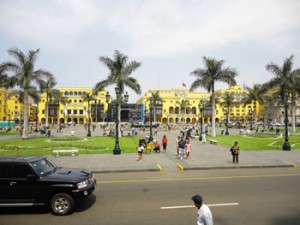Recent Articles
PURSUING MACHU PICCHU AND THE FOOD AND WINE OF PERU
Greg McCluney • 7/20/11  Print This Post
• Comment
Print This Post
• Comment

Machu Picchu, the Inca’s Sacred City in the Clouds

The City in the Clouds
Long on my bucket list of places to visit, Peru’s City in the Clouds, Machu Picchu receives thousands of visitors from around the world every year. Twenty thousand years of history and a Wonder of the World, Machu Picchu and the lands surrounding it were home to a scientifically advanced Incan civilization.
But despite the tourism numbers, it’s not an easy place to visit. Peru is a South American success story, much as Chile was and is, but the high altitudes, weather, infrastructure, foods and water systems can be a real challenge to many visitors. Is it worth the effort? It was for us, as you’ll see in this quick tour.
Peru is the third largest country in South America (with a population of 28 million) and is geographically diverse – from the dry coast to the Andes Mountains to the Amazon jungle. Each region contributes to an agricultural abundance that produces fresh fruits, grains, game, fresh fish and, yes, grapes. Lots of them.
While you may never see a bottle of Peruvian Merlot, it does exist. However, most grapes are harvested to make Pisco, a grape brandy and the national drink of Peru. Four varieties of Pisco are made from strange-sounding grapes such as Mollar, Uvina, Torontel, Albilla and Moscatel. The most popular drink, the Pisco Sour, is a bit like a whiskey sour that has been made with neutral spirits.

Now one of the seven wonders of the world, “MP” shocks and rocks!
The Food
The evolution of Peruvian cuisine in the last ten years has received international recognition. Lima was recently recognized by Bon Appetit magazine as the “Culinary Destination of the Year.” Home of the ubiquitous potato, often three and four versions will accompany a single meal. Peru is much more than meat and potatoes — especially in the capital city of Lima.
Popular local specialties include Chupe de Camarones (a shrimp soup with red chilies, poached eggs, rice and milk), Juane (a chicken and rice dish with many spices and olives in a Bijao leaf from the Amazon), Lomo Saltado (beef in purple onions, tomatoes, peppers and soy), and Cebiche de Pescado (fresh fish with spices in lemon juice).

Yes—four kinds of potatoes begin your dinner!
Fine dining in Peru is a formal experience with superb service, silver and linens, beautiful dining rooms — all at about one-third the cost of a similar dinner in Atlanta. In fact, because the dollar is fairly strong against the local currency, the nuevo sol, prices in general are about 60 percent below the U.S.
Further, we were amazed to find and feast in the popular “Chifa” restaurants in almost every city, which are Peru’s take on Chinese cuisine –- with a zesty makeover. Asians represent a sizable percentage of Peru’s population and prefer this flavorful combination of two cuisines a world apart.
Peruvian Premium Wines
With all the attention to the Pisco cocktail and raising grapes for this brandy, we began the search for some premium varietals from Peru in shops and restaurants. Eventually it became clear that the premium end of the industry, while not new to this country, is quite small. We were glad to see that most restaurants did list some local wines, along with many more selections from Chile and Argentina, which are also very reasonable. Other imports from the U.S., France, et al, are subject to a steep tax and quite expensive.

Your author searching for a “star” in a Lima wine shop.
For most of our meals, we stayed mainly with various bottles from two Peruvian producers: Tabernero (their Gran Tinto Malbec-Merlot was quite good) and Santiago Queirolo (where their Tannat stood out). Both are from grapes grown in an area south of Lima, the Valle de Ica. Both have been making wine for many years and have won awards in French and Spanish wine competitions.

A 2008 Santiago Queirolo Tannat was perfect for a local beef dish, Lomo Saltado.
While the purpose of the trip was not a wine junket, it seems from talking with our restaurant servers, staff and owners, that the premium part of Peru’s wine industry is expanding, albeit slowly.
Below: A photo tour of some highlights of the Mystical Land of the Incas

A journey to Peru begins in the attractive seaside capital of Lima

Visitors enjoy a Peruvian folklore show in a Lima club

The trip to MP begins in Cusco, the capital of the Incan empire, elevation 10,400 feet

Part of the 3-stage day trip to MP is aboard Peruvian Rail’s special scenic Vista car service

Shopping at 14,000 foot elevation can take your breath away

A final toast to Peru in a Lima restaurant built over the Pacific Ocean
One comment so far for “PURSUING MACHU PICCHU AND THE FOOD AND WINE OF PERU”
I enjoyed reading your blog. Such a great place to visit and amazing food. Wonderful wine and tradition!